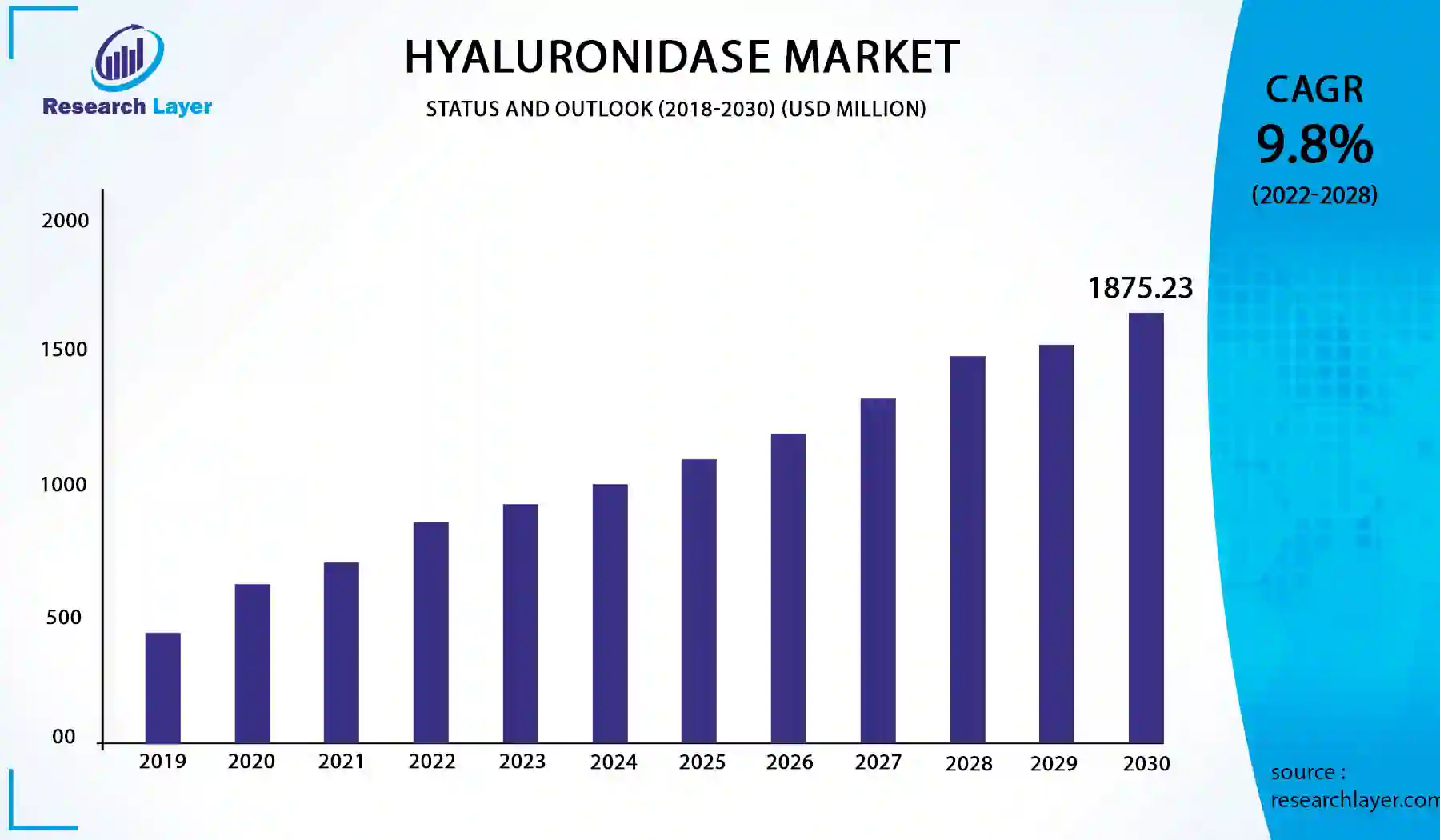 +1 915 229 3004 (U.S.) |
+1 915 229 3004 (U.S.) |  +44 7452 242832 (U.K.)
+44 7452 242832 (U.K.)
 +1 915 229 3004 (U.S.) |
+1 915 229 3004 (U.S.) |  +44 7452 242832 (U.K.)
+44 7452 242832 (U.K.)


Research Layer announces the publication of its half-cooked research report— Global Hyaluronidase Market, 2022-2030
According to Research Layer, the global Hyaluronidase Market has been segmented into component, communication infrastructure, device usage, end use, and region/country. The global Hyaluronidase Market is expected to surpass USD 1875.23 Million by 2030 with a CAGR rate of 9.8% during the projected period.
Hyaluronidase is used in ocular therapeutics, cancer treatment, and cosmetic procedures. The use of enzyme-based substrates for noninvasive tumour imaging is expected to increase demand, giving rise to new opportunities in the fields of cancer metastasis and therapy.
The global Hyaluronidase Market has been segmented based on Type, Application, and region/country.
Based on the Type, the Hyaluronidase Market has been segmented into Animal-derived Hyaluronidase, Synthetic Hyaluronidase. Animal-derived Hyaluronidase held the largest share for the market. This dominance is owing to most approved brands that are available are animal-derived enzymes
Based on the Application, the market has been segmented into Chemotherapy, Invitro Fertilization, Ophthalmology, Dermatology and Others. Dermatology held the largest share for the market. Hyaluronidase enzyme promotes the diffusion of injected fluids in the tissues and facilitates their absorption. Furthermore, it increases the action of local anesthesia, and prevents the risk of necrosis.
The global Hyaluronidase Market has been analyzed for five regions—North America, Europe, Asia-Pacific, the Middle East & Africa, and South America.
The demand for cosmetic and aesthetic procedures has also increased as people have become more open to the idea of changing their appearance. The rising incidence of skin problems and the availability of cutting-edge aesthetic therapies in many parts of the world are largely responsible for the growing demand for hyaluronidase in cosmetic dermatology. The rising ageing population, positive reimbursement policies, and the increasing popularity of nonsurgical cosmetic operations are other contributing reasons. Hyaluronidase therapy is useful for dissolving subcutaneous nodules and correcting the effects of over-injection of fillers. As a result, experts in the cosmetics business have been more curious about this enzyme and its potential benefits and drawbacks.
Enzyme utilisation for hyaluronic acid filler maintenance has risen for the reasons described above. Overdosing on hyaluronidase can cause impaired vision, sweating, and confusion among other symptoms. However, rapid heartbeats, skin rashes, odd weakness, and dizziness are rare side effects of a subcutaneous injection. Therefore, the doctor or beautician must be familiar with hyaluronidase dose, side effects, and treatment options. Key participants in the hyaluronidase market can anticipate to benefit from developments aimed at minimising the unpleasant side effects of hyaluronidase treatment.
The chemotherapy market in North America is a major player internationally. High rates of skin cancer, lung cancer, breast cancer, ovarian cancer, and other malignancies in the region are mostly responsible for this expansion. In the United States, for instance, the number of cancer survivors is projected to rise from the current 15.5 million to reach 20.3 million by 2026. In addition, the National Cancer Institute predicted that 1,735,350 people will be diagnosed with cancer in the United States in 2018; an estimated 609,640 would succumb to the disease. Hyaluronidase is one of many novel cancer medicines that is projected to have a sharp increase in demand between now and 2025. Therefore, the growth of the North American hyaluronidase market is being fuelled by the fact that most of the key players are investing heavily in research and development activities and making extensive use of cutting-edge technologies in R&D in order to meet the forthcoming demand and grab the majority share of the market.
The key players in the global Hyaluronidase Market are Amphastar Pharmaceuticals Inc., Halozyme Inc., Bausch & Lomb Incorporated, the Cooper Companies Inc., Sun Pharmaceutical Industries Ltd., STEMCELL Technologies Inc., Shreya Life Sciences Pvt. Ltd., Calzyme, Dermax Medical Technology (Hebei) Co., Ltd., Hangzhou Techderm Biological Products Co., Ltd., Jinan Elinkmax Business Co., Ltd., Shandong SAC Refractory Co., Ltd., Shijiazhuang Yiang Technology Co., Ltd., Hangzhou Singclean Medical Products Co., Ltd., Hebei Puling Technology Co., Ltd., Guangzhou Otesaly Ltd, Xiamen Vecon International Co., Ltd., and Others.